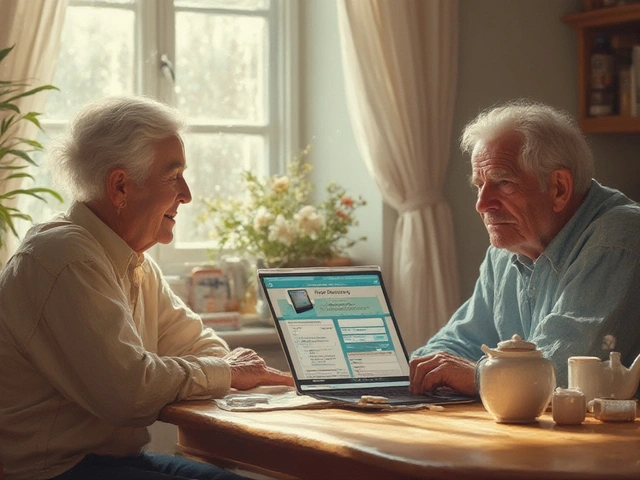Heartburn isn’t just something that pops up in cheesy TV ads—it’s a real pain for millions every day. Maybe you’ve felt it: that burning sensation creeping up after a spicy dinner or a greasy burger. Suddenly it’s less about enjoying food and more about surviving until relief kicks in. When people reach for fast fixes, Prilosec often pops up as the go-to. But what exactly is Prilosec, and how does it stack up when you’re desperately searching for relief?
What Is Prilosec and How Does It Actually Work?
Prilosec, known scientifically as omeprazole, is a proton pump inhibitor (PPI). This group of drugs doesn’t just mask the symptoms—it goes to the root of stomach acid production. Here’s the deal: your stomach cells act like little factories, pumping out acid to digest food. But when your body goes into overdrive, welcome to the world of acid reflux and heartburn. Prilosec steps in and tells those factories to slow down.
That’s not just guesswork. By 1990, omeprazole was already getting nods worldwide for its ability to actually heal damage caused by acid, not just give temporary relief. This isn’t your quick-fix antacid—it’s designed for daily use, building up in your system over a few days to bring acid under control. Most people report noticeable improvement within four days. In fact, in a major study published in the American Journal of Gastroenterology, 70% of users with daily heartburn said they had major symptom relief in the first week.
But is it only for heartburn? Nope. Doctors also prescribe Prilosec for gastroesophageal reflux disease (GERD), stomach ulcers, duodenal ulcers, and rare conditions like Zollinger-Ellison syndrome where acid production ramps up to wild levels. So, if you're living with chronic symptoms, you’re definitely not alone—and you’ve got backup.
Since its FDA approval in 1989, Prilosec has become one of the most prescribed drugs in the United States. Omeprazole, the active ingredient, was even the number one prescribed gastrointestinal drug for many years, based on prescription volume. That’s not marketing hype. Its popularity grew so much that it went over-the-counter in 2003. A quick stroll through any pharmacy will show Prilosec occupying prime real estate on the shelves.
Want a quick snapshot of just how common acid-related problems are? Here’s a table that puts it in perspective:
| Condition | Estimated U.S. Adults Affected (2024) |
|---|---|
| Chronic Heartburn | 60 million monthly |
| GERD | 20% of adults |
| Stomach Ulcers | 4.5 million annually |
| Zollinger-Ellison Syndrome | Less than 1 in 1 million |
Now, here’s something wild: Prilosec isn’t instant. It usually takes 1-4 days to feel the full effect. So, if you’re looking for “bam!” relief, chewable antacids might be your best bet short-term while Prilosec gets busy behind the scenes. But for ongoing issues, omeprazole’s all about playing the long game.
Also, don’t be shocked if your doctor suggests taking Prilosec first thing in the morning—right before food. Why? This is when those acid factories are waking up, ready to work at full tilt. The timing isn’t random. Swallow the tablet whole—never crush or split it—since the special coating protects it from stomach acid until it reaches its target.

Possible Side Effects and When to Call the Doctor
Now, onto the stuff nobody wants to talk about: side effects. If you ever scroll through online forums, you’ll find all sorts of stories. Some people swear by Prilosec, while others say it gave them stomach troubles or headaches. Most folks handle it pretty well, but knowing what could pop up helps you make smarter choices.
The most common side effects are pretty mild—think headache, nausea, diarrhea, or a bit of stomach pain. They usually settle down after your body adjusts. According to a massive review involving more than 14,000 patients, less than 5% had to stop Prilosec because of side effects. That’s a pretty low dropout rate for any medication taken over weeks or months.
Still, a few things can catch you off guard. Sometimes people get muscle cramps or feel unusually tired. Here’s a tip: Prilosec can mess with how your body absorbs magnesium and even vitamin B12 if you’re on it for more than a year. If you ever feel muscle weakness or tingling hands and feet, mention it to your doctor. Blood tests can catch those rare deficiencies before things get crazy.
Long-term use has sparked some debates in the medical world. Studies found a small bump in the risk for certain infections, like Clostridium difficile in the gut or pneumonia. Why? Stomach acid is part of your body’s defense team, neutralizing nasty bacteria. Less acid means a slightly easier path for germs. That being said, if you’re healthy and not on a bunch of other meds, the added risk is pretty tiny.
Here’s a quick “should I call the doc?” checklist for anyone on Prilosec:
- Severe or persistent diarrhea (especially if watery or contains blood)
- Unexplained severe muscle cramps, numbness, or seizures
- Extreme fatigue or weakness
- Allergic reaction signs like rash, itching, swelling, or trouble breathing
One random tidbit: Prilosec can cause false positives on some urine tests, especially for drugs like THC. So, if your job or school does random screenings, mention your prescription if you test unexpectedly positive. Always keep your medication bottle handy for situations like that.
Interactions with other meds? Totally real. Prilosec can mess with drugs that rely on stomach acid for absorption—like iron supplements or certain antifungals. It also interacts with clopidogrel, a blood thinner. That’s why your doctor or pharmacist should know every pill, vitamin, or supplement you take. I’ve got a friend who ended up with a major migraine because his migraine meds absorbed too fast while on Prilosec. So, honesty at the pharmacy counter pays off.
This brings up another fun fact: not all proton pump inhibitors are the same for everybody. Genetics matter! A small chunk of the population breaks down omeprazole super-fast or super-slow, which can mean too little or too much in your system. If Prilosec just isn’t hitting the mark, mention it to your doctor—they might switch you to a different PPI or check your dose.

Making the Most of Prilosec: Tips, Fun Facts, and Everyday Wisdom
You’d be surprised how much the little stuff matters when taking Prilosec. Found yourself skipping doses or popping more to compensate? Not the best strategy. PPIs want consistency—same time, every day, on an empty stomach. Doing that, you’ll get steady results and avoid swings in acid production. I’ve had nights where Natalie asked if I took my pill or not, and trust me, you notice the difference if you skip.
Don’t chase it with grapefruit or orange juice. Citrus is a heartburn magnet for many folks. Water is your best friend here. And while Prilosec can handle big meals, steering clear of spicy, fatty, or fried foods helps the process. Late-night snacks? Maybe give those up, at least right before bed. Prilosec won’t protect you from everything the midnight fridge-raid throws at you.
Here are some real-life hacks from people who’ve been there:
- Prop yourself up in bed with extra pillows. Gravity is a surprisingly good antacid.
- Wear loose-fitting clothes, especially around the waist. Tight belts and jeans press on your stomach and can push acid up.
- Watch your portion sizes at dinner. The fuller your stomach, the closer acid is to the top—and that’s your esophagus’s problem to solve.
- Wait at least 2-3 hours after eating before lying down. Why rush the process?
- Cut back on coffee, chocolate, and alcohol. Yes, it stinks, but they’re repeat offenders for making reflux worse.
If you want to get technical, Prilosec comes in both 20mg and 40mg strengths. For most over-the-counter cases—occasional heartburn after foods—the 14-day packs are standard. But if your doctor has you on higher doses (some go up to 80mg a day split into two doses for serious problems), follow their instructions. The key: use the lowest effective dose for the shortest time possible. The FDA recommends sticking to 14 days at a stretch for heartburn, then taking a break for at least four months before repeating. This avoids unnecessary risks and lets your body reset.
Here’s something you might not expect: stress can crank up your stomach acid, even with Prilosec on board. Doing a bit of meditation, deep breathing, or whatever helps you decompress can make a difference. I’ll admit, the days when work gets wild and I forget to hit pause, my stomach lets me know. So, give yourself little breaks, especially if you’re dealing with reflux. It may sound cliché but it works for lots of people.
Don’t go mixing Prilosec and antacids at random. If you need extra relief—maybe your burrito backfired—wait at least 30 minutes after your morning Prilosec dose before reaching for an antacid. This lets the omeprazole get absorbed before anything else comes in and tries to change the acidity in your stomach. Small thing, but it makes your medication more effective.
Lastly, if you’re taking Prilosec regularly but symptoms stick around, or they get worse after you stop, always bring it up with your doctor. Sometimes acid reflux is a sign of something bigger, like a hiatal hernia or, in rare cases, an esophageal issue that needs a closer look. No medication is a forever fix for everyone. You know your body best. If something feels off, trust your instincts and ask questions.
So, Prilosec isn’t magic, but it gives a lot of people room to enjoy food and life again without the burn. Used smartly, with a bit of real-world wisdom and listening to your body, it can be a game-changer in the daily quest for comfort.







Michael Taylor
June 5, 2025 AT 10:09